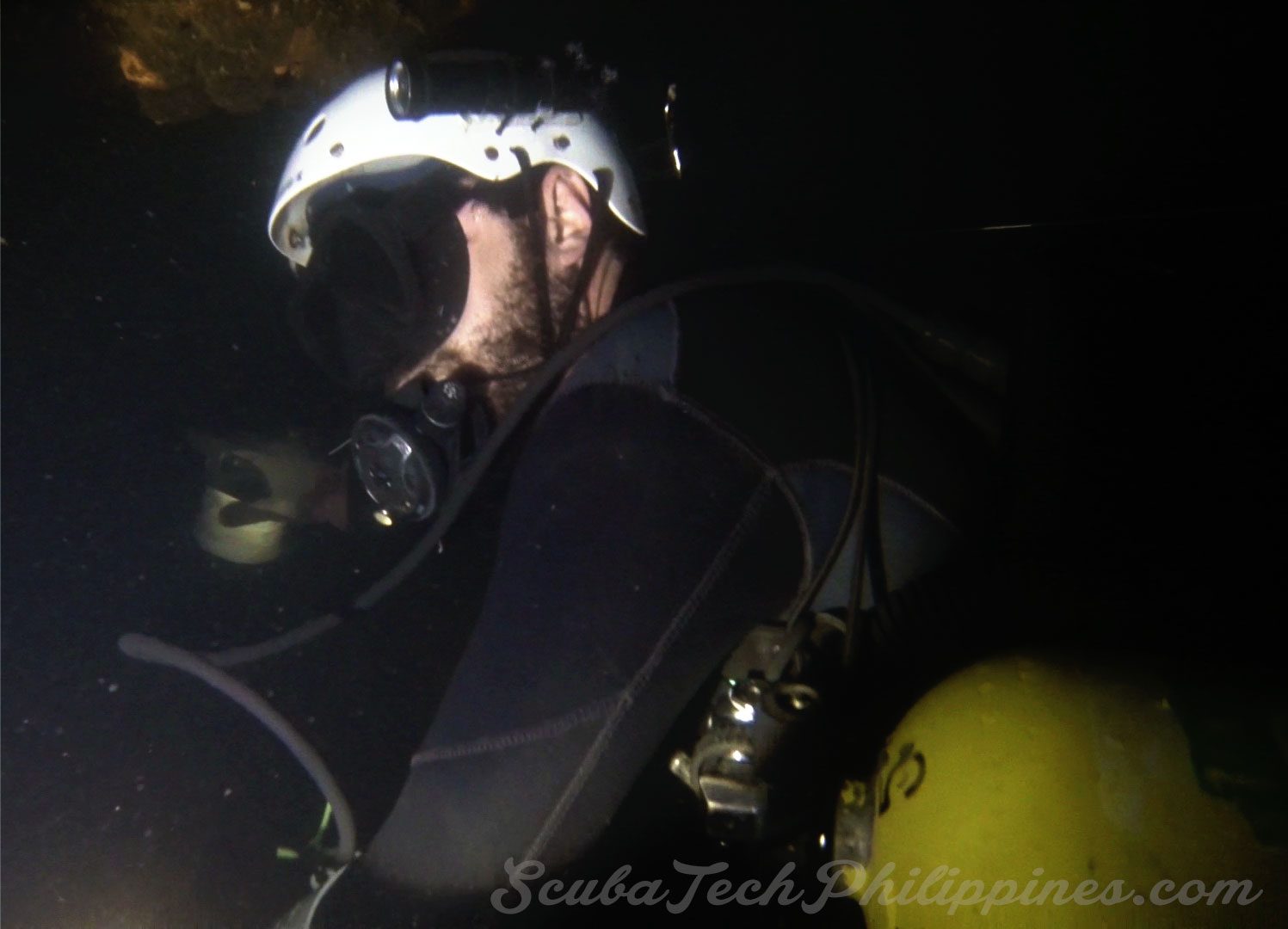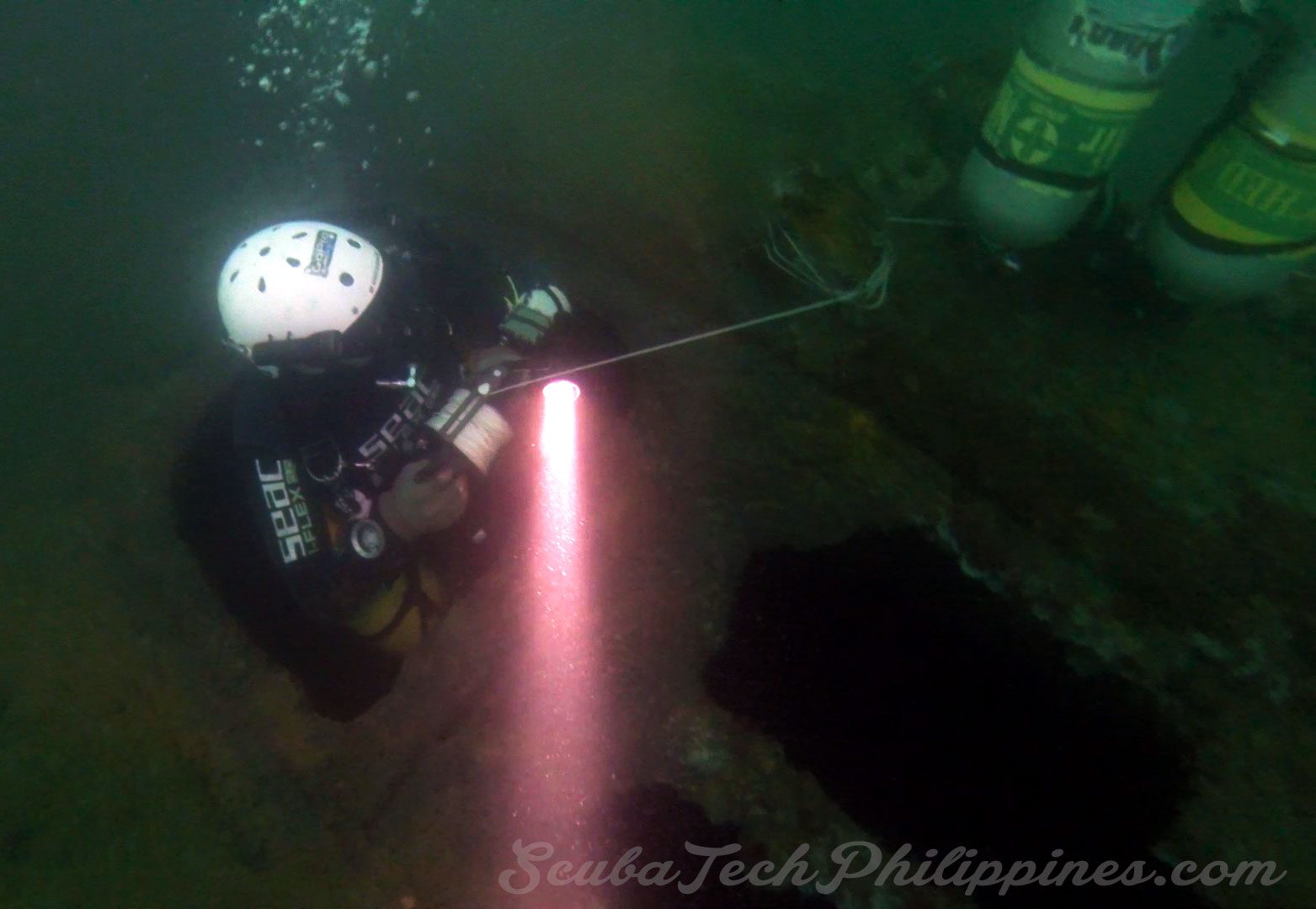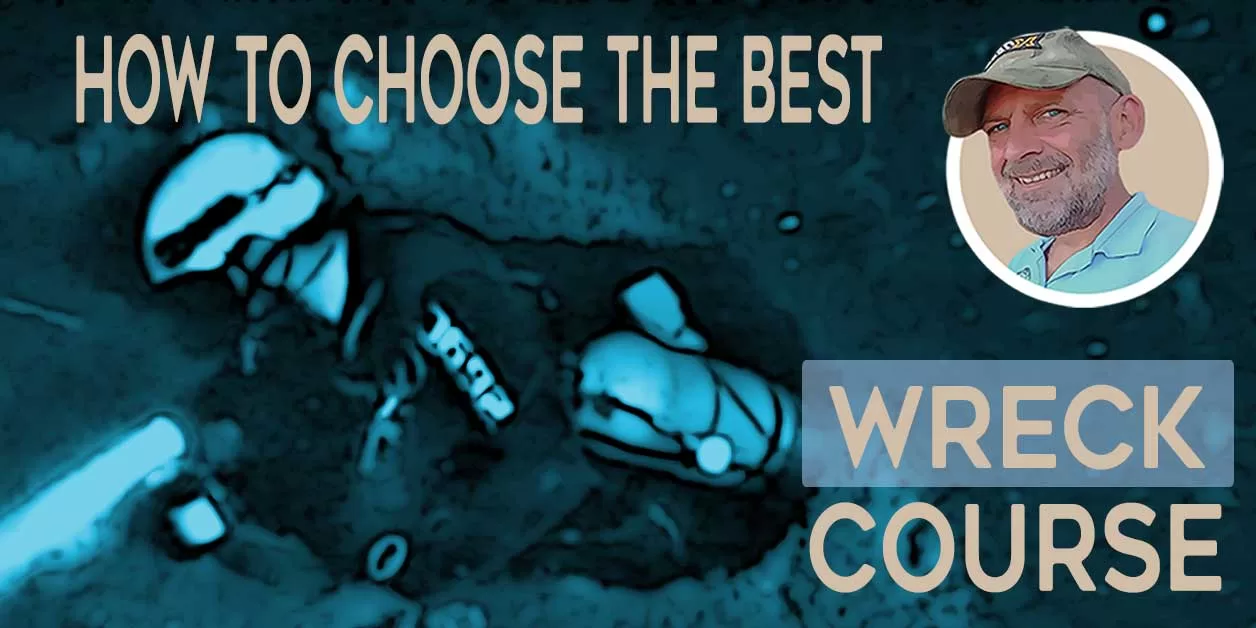Technical Wreck Course: What Is Advanced Wreck Training Like?
A technical wreck course (sometimes called ‘advanced wreck‘) is a pinnacle-level diving course for highly qualified technical divers who wish to penetrate extensively inside shipwrecks. Whilst the primary skills and drills taught in these courses are identical wherever they are taught, the focus and philosophy of training can vary significantly by region or by the individual instructor.
In this article, I will attempt to explain the general components and structure of a technical wreck course, along with my personal interpretation, as a technical wreck instructor with 2 decades of teaching experience, of how I focus and run my courses here in Subic Bay.
The photos used to illustrate this article are all still shots taken from GoPro footage of a technical wreck course that I ran on the wrecks of Subic Bay in January 2016. My French student, Robin, was already a well-known cave explorer and instructor. We conducted a technical-level sidemount course and fundamental skills clinic before doing the technical wreck course.
The total training was 10 days. I video my courses to enable constructive post-dive debriefs and student self-analysis. This is a very effective learning tool that promotes rapid development.

Length of a Technical Wreck course
Most technical wreck courses are 4-8 days in length, with 2 dives per day. There are 2 dives conducted per day, often lasting in excess of 90 minutes each. There is also theory study in the classroom and lots of skill rehearsals on dry land; especially with regard to guideline drills and line-laying.
The need for physical fitness
Students should be in good physical shape for this training. It demands some diver endurance and durability.
Some divers prefer not to prepare for courses with physical conditioning exercise. Instead, they will get through each training day at a point of exhaustion. In turn, this can lead to degraded learning potential. Also, it causes more physiological and psychological stress over-load.

Prerequisites for a technical wreck course
Prerequisites for a technical wreck course are normally:
- Basic wreck diving qualification
- Technical diving certification
The depth of required technical diving certifications may be determined by the depth of the wrecks at the location where the instructor conducts the course.
The need to practice and repeat (to a high level of accomplishment) many drills on each dive dictates long bottom times; hence the deco requirement.

Emphasis on wreck depth or wreck penetration?
Some instructors view a technical wreck course with an emphasis on accessing deep wrecks (technical decompression).
In contrast, other instructors view the course chiefly as an intensive overhead environment training course, irrespective of depth, with the focus being on developing very refined guideline skills and emergency protocols.
Again, these perspectives are often shaped by the depth and nature of the wrecks where the instructor operates.
Different approaches to technical wreck training
There is a range of approaches to technical wreck diving. Many technical wreck instructors borrow heavily from the cutting-edge refined procedures, approaches, and protocols being formulated by exploration-grade cave divers.
In contrast, other ‘deep ocean’ technical wreck instructors develop more rugged approaches to diving; aimed at operating in demanding water conditions (current, water temperature, etc).
Regional differences in technical wreck diving philosophy and practices
There are distinct ‘schools of thought’ that characterize the diving, for instance, of North-East USA ‘wreckers’, European or UK wreck explorers, and those emulating the Florida/Mexico cave-inspired best practices.
The best instructors make it their mission to understand and experience all of these approaches and, to quote Bruce Lee, “absorb what is useful and disregard the rest“.
Nonetheless, wrecks are a distinctly different environment to caves. As such, any instructor teaching technical wreck courses should have expertise in that environment. Cave diving qualifications don’t prepare divers to enter ocean wrecks, just as a wreck certification doesn’t prepare someone to safely enter a cave.

The experience and proficiency needed for technical wreck courses
In addition to the certification prerequisites, technical diving students enrolling in a technical wreck course are expected to have solid experience and high competency in fundamental diving skills.
This means that technical diving, and conducting decompression, should be second-nature to them.
The need for solid fundamental skills
It also means that they can maintain flat, horizontal trim consistently; regardless of distractions and a severe level of task loading.
Any tendency towards dropping the legs and kicking silt should de-bar the student from entry onto the course. In this case, remedial training is necessary before progression into the wreck.

The first day of my technical wreck courses consists of paperwork, logistics, equipment, and check-out dives. I run an equipment workshop to help students refine and ‘clean’ their technical rigs ready for penetration into confined, dark environments.
Diving equipment configurations for technical wreck courses
Courses can be run in sidemount, back-mount, or CCR. My bias is always for sidemount, as this promotes easier penetrations in confined, tight environments – but given the cost of helium, very deep technical wreck courses/dives are cost and decompression efficient when CCR is used.
There are now a few sidemount CCR units on the market and these are definitely getting some attention from the deep cave and wreck divers.

Pre-training assessment for technical wreck courses
The initial check-out and skills dives are conducted in open water. This gives the instructor a chance to assess the student’s strengths and weaknesses before entering an actual wreck. It also gives students the chance to make final tests, tweaks, and adjustments to their equipment.
The first two dives of a technical wreck course
Following some dry-land rehearsals, the students will:
- Conduct intensive training laying and retrieving lines
- Use safety spools for lost guideline and lost diver search drills
- Conduct air-sharing protocols in zero visibility
- Practice tactile and touch communications
- Rehearse entanglement drills
These two dives, done in shallow water wherever possible, can easily be as long as 120 minutes each. It is a very long day.

Zero visibility practice
Technical wreck divers have to be able to conduct every critical skill even if they lose visibility in a silt-out. So, once skills are learned and practiced with vision, they are then repeated in blacked-out masks. This replicates zero visibility.
During this process, the student also develops more effective stress management skills and equipment familiarity. Operating technical diving equipment by touch alone works wonders for developing an instinctive and intuitive understanding of your kit.

Actual wreck penetration dives
Once the necessary skills and drills have been mastered in open water, the training switches to the overhead environment. Again, everything that was done previously in open water is now repeated and refined inside an actual wreck.
This brings added learning aspects for the student. For instance, they now have to deal with silty conditions and more difficult situational awareness.
Light skills become critical, both signaling and because they hamper other skills (especially canister lights) if the student does not follow protocols exactly.

Technical wreck course: dive planning
Dives are planned to maximize bottom time for training, using a suitable gas. This is because there is often decompression to complete before surfacing. The students are expected to plan and manage the dives. Meanwhile, the instructor simply runs them through the necessary skills.
This also places realistic task-loading and situational awareness demands on the student divers. Again, this necessitates that student technical wreck divers are suitably experienced in technical diving.

Applying real-world technical wreck skills
In my courses, I make sure that students spend considerable time in and around silty areas of the wreck. This exposes any fundamental breakdowns in trim and finning discipline. The student’s immediate feedback is often a real-time loss of visibility.
I direct penetration routes that further test the student’s ability to operate in unusual orientations. This will include vertical (head-down) and even upside-down passages.
Sometimes a passage may be too tight to allow the technical wreck diver to re-orientate themselves the right way up. For that reason, being able to complete shut-down drills, or even mask clearances, in every possible orientation is important.
Many divers, even technical divers, don’t practice their skills out of horizontal trim. Consequently, this is often a steep learning experience for them. For instance, mask clearing when upside down can involve a lot of water up the nose.

Technical wreck student stress and comfort zone
As the training dives progress, I pay careful attention to the student’s level of stress and capability.
My goal is to enable the greatest possible development by consistently pushing the student beyond the outer limits of their comfort zone.
Also, I need to keep training safe and ensure that too much stress doesn’t impede their learning.
Every technical wreck course is subtly different. The experience is tailored to the strengths and weaknesses of the individual students.

The psychology of technical wreck diving
This psychological learning process is also critical for the student. It empowers them to develop a realistic self-understanding of their dive psychology whilst under pressure.
I encourage my students to be aware of their psychological and physical comfort during the training dives. As a result, they use that experience to set their own individual limitations and boundaries.
Practice develops skills refinement and exposure to intimidating conditions develop mental resilience.
Importantly, the student should learn to self-diagnose an unacceptable level if stress. They should know when the demands of dive are overloading their skill competencies or physical ability.

Line-laying on a technical wreck course
Through the courses, the student divers will lay many hundreds of meters of the guideline. Laying guidelines in a wreck is one-half science and one-half art.
The student diver must become accustomed to selecting a safe route through the wreck. Subsequently, they can lay guideline so that it allows a timely and unimpeded exit. That must also happen in zero visibility.
As the course progresses, students develops the science of identifying and forward-planning their tie-offs. They progress into the wreck and using a little artwork in their choice of appropriate angles to lay the guideline optimally. It must be easy and intuitive to follow.

Passing restrictions inside of wrecks
The last phase of my technical wreck skills training is that of passing restrictions. Restrictions are traditionally defined as spaces where two divers cannot pass through whilst sharing air side-by-side. However, for technical wreck divers, restrictions demand a much more detailed classification.
There are spaces where two divers can pass whilst sharing air in long-hose, but tighter spaces might involve some time and wriggling to get through.
The tightest spaces may involve:
- Removing items of equipment
- Teamwork to pass equipment or cylinders through
- Safety decisions on whether the diver should pass head-first or feet-first
- Consideration of air-sharing support throughout the process of getting past a restriction.
You can read more about defining wreck restrictions.

Learn, ingrain, and apply technical wreck skills
My training philosophy is that learning, ingraining and applying skills are fundamental to creating competent technical and overhead environment divers.
When I conduct technical wreck courses here in Subic Bay, Philippines, I am lucky to have the USS New York ACR-2 armored cruiser as a training site.

This is an impressive wreck that permits extensive multiple-deck penetrations in heavy silt and confined spaces. There are numerous routes through the wreck that range in demand and severity.
My choice in allocating penetration routes largely depends on the student’s comfort and competence.

Whilst the USS New York is physically large, many of the internal compartments are tight and confined. The wreck lies on its side, so the layout and navigation are often confusing. Visibility outside isn’t good and can disappear in a second if a single fin is moved carelessly.
It is not a place for those anxious of the dark. Divers who are claustrophobic or prone to stress overload shouldn’t go inside. Hence, there is a build-up process in more benign wrecks first. Luckily, Subic has more than a few wrecks to develop upon.

When applying the technical wreck skills training on actual penetration-exploration dives, there are no fictitious scenarios; the demands are real.
Conducting real technical wreck training dives
They are real penetration dives planned in exacting detail. The student has a lot of task management to deal with throughout. The conditions and parameters of the dives are hazardous. As a consequence, only the newly mastered skill set of the students allows them to mitigate the risks.
Two technical wreck divers, one of them an instructor, lost their lives together inside the USS New York only a few years ago.
I make sure that one of the first penetration dives routes past the plaque laid where they perished. It is both sobering reminder of why we train diligently and work to maintain and improve our skills beyond certification.

Doing technical wreck training in Subic Bay has several advantages:
- Firstly, many of the wrecks are relatively shallow; in recreational depth ranges (most at less than 32m). This means that we can do very extended bottom times without a huge decompression obligation.
- Secondly, it alleviates the need to pay for helium fills to offset narcosis. Trimix gas fills are very expensive, especially in the Philippines. If we only had deep wrecks to dive upon then the course costs would rise much higher.

The length of a technical wreck course is important
As the training progresses, technical wreck students get progressively more comfortable and accomplished. I do not favor minimum-timescale courses where the bare requirements are achieved.
Technical wreck diving is a hazardous activity and enough training dives need to be completed. Short courses do not enable a solid foundation of skill application and real experience.
The more we dive, the more problems and variables we encounter. We have to expand our experience with real-time lessons learned, not just hypothetical understanding.

Pay for training, earn the technical wreck certification
The student pays for their training but has to earn their qualification. In doing so, they deserve a true sense of fulfillment and accomplishment.
Unlike many scuba diving certifications, technical wreck courses are a level that demands the very highest standards. It also requires contentious, motivated instructors who will not compromise on the quality of diver competency.
Whilst true perfection can never actually be attained, technical wreck is best suited to those who pursue excellence and train themselves diligently towards that goal.

If you have an interest in learning technical wreck diving, please do message me. I am always happy to discuss training strategies over the long, medium, and short terms so that divers can ultimately accomplish their goals.
Technical wreck diving isn’t for everyone, but if you are considering taking your wreck diving to the highest levels, then the time to start working towards that ambition is now.
About The Author

Andy Davis is a RAID, PADI TecRec, ANDI, BSAC, and SSI-qualified independent technical diving instructor who specializes in teaching sidemount, trimix, and advanced wreck diving courses.
Currently residing in Subic Bay, Philippines; he has amassed more than 10,000 open-circuit and CCR dives over three decades of challenging diving across the globe.
Andy has published numerous diving magazine articles and designed advanced certification courses for several dive training agencies, He regularly tests and reviews new dive gear for scuba equipment manufacturers. Andy is currently writing a series of advanced diving books and creating a range of tech diving clothing and accessories.
Prior to becoming a professional technical diving educator in 2006, Andy was a commissioned officer in the Royal Air Force and has served in Iraq, Afghanistan, Belize, and Cyprus.
In 2023, Andy was named in the “Who’s Who of Sidemount” list by GUE InDepth Magazine.
Purchase my exclusive diving ebooks!
About The Author

Andy Davis is a RAID, PADI TecRec, ANDI, BSAC, and SSI-qualified independent technical diving instructor who specializes in teaching sidemount, trimix, and advanced wreck diving courses.
Currently residing in Subic Bay, Philippines; he has amassed more than 10,000 open-circuit and CCR dives over three decades of challenging diving across the globe.
Andy has published numerous diving magazine articles and designed advanced certification courses for several dive training agencies, He regularly tests and reviews new dive gear for scuba equipment manufacturers. Andy is currently writing a series of advanced diving books and creating a range of tech diving clothing and accessories.
Prior to becoming a professional technical diving educator in 2006, Andy was a commissioned officer in the Royal Air Force and has served in Iraq, Afghanistan, Belize, and Cyprus.
In 2023, Andy was named in the “Who’s Who of Sidemount” list by GUE InDepth Magazine.
Purchase my exclusive diving ebooks!
Originally posted 2018-03-07 23:57:09.















